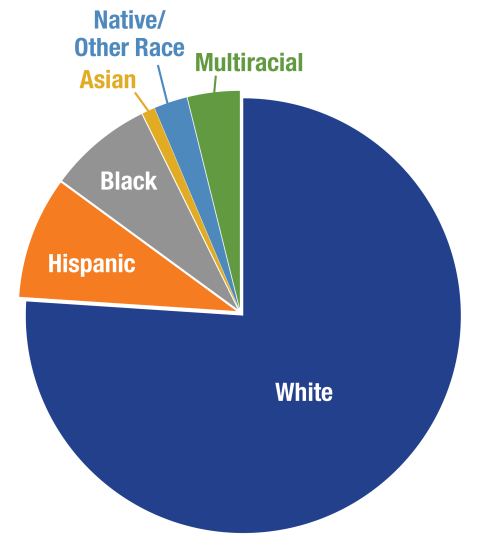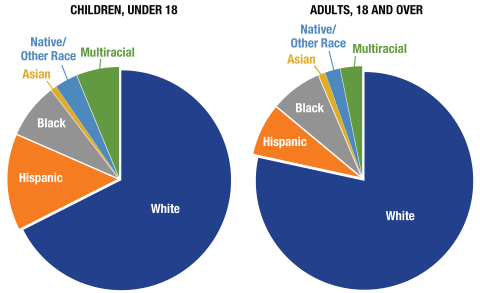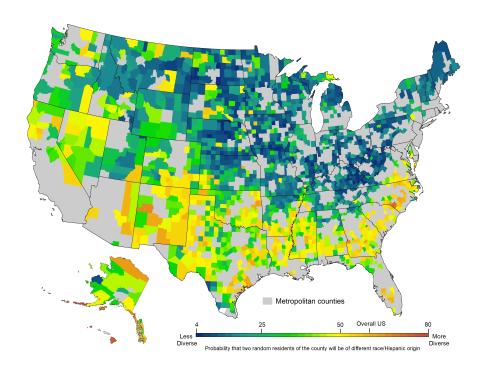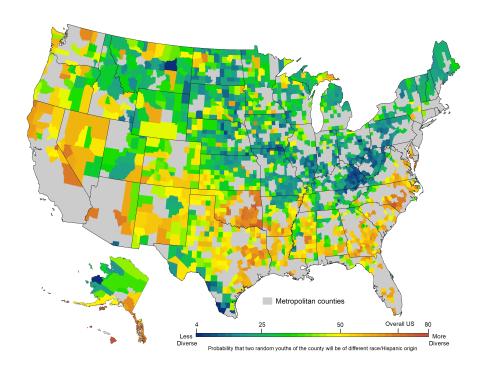Key Findings




Many rural areas have been hit hard over the past decade by globalization, a rapidly changing U.S. economy, job instability, and high unemployment. The net result has been migration losses and low fertility. As a result, only about a third of nonmetropolitan (rural) counties gained population between 2010 and 2020. The other two-thirds lost population. In some cases, the losses were modest, but nearly one in three rural counties have experienced chronic population decline. And, for the first time ever, rural America as a whole lost population between 2010 and 2020. Recent 2020 Census data revealed that nonmetropolitan counties declined by 288,000 people (or 0.6 percent) between 2010 and 2020, after growing by 3.4 percent during the previous decade. Today, there are 46 million rural residents, which is just 14 percent of the U.S. total. This is the smallest percentage of the population to reside in rural areas in U.S. history.
Though population declines were widespread, rural America became more racially and ethnically diverse over the past decade. Rural population decline occurred in tandem with growing rural diversity. As we show in this report, the growing diversity of the nonmetropolitan population reflects differential patterns of demographic change among the numerous racial and ethnic sub-groups in rural America.
The growing diversity of the rural population over the past decade reflects uneven growth and decline among America’s racial and ethnic groups. If each racial group grew (or declined) at the same rate, the racial composition of rural America would remain invariant over time. But this has not been the case.
In part, the recent uptick in racial diversity in rural America is a consequence of White population decline. Rural America remains predominately non-Hispanic White with 35 million White residents constituting 76 percent of the rural population according to the 2020 Census. This represents a decline from 79.8 percent in 2010. There are roughly 2.0 million fewer rural Whites in 2020 than in 2010. In contrast, the number of rural residents who are members of a racial or ethnic minority increased to 11 million between 2010 and 2020, which is 24.0 percent of the nonmetropolitan population compared to 20.2 percent in 2010. Working in demographic concert, White population decline coupled with widespread minority population growth is gradually transforming the racial and ethnic composition of rural and small-town America.
Hispanics represent the largest share of the rural minority population, with a population of 4.1 million or 9.0 percent (Figure 1). The Census also enumerated 3.5 million non-Hispanic Black people, representing 7.7 percent of the nonmetropolitan population, a decline from 2010. The population reporting that they were Native Peoples or of “Some Other Race” (1.1 million) increased to 2.5 percent. Asians remain a small rural minority group, only accounting for 1 percent of nonmetropolitan population.

Note: Hispanic category includes Hispanics of any race. All other categories include only non-Hispanics. Source: U.S. Census 2020.
The largest population gain was among non-Hispanic Multiracial residents, who at 1.8 million, now represent 3.9 percent of the rural population. This reflects changes in how the Census Bureau measures racial identification, as well as a new willingness to identify as mixed-race.1 It also is due to increasing births among the growing number of interracial couples. The Multiracial population blurs the racial boundaries that often separate Whites from racial and ethnic minority populations and underscores how the perception of race in America has continued to evolve through the nation’s history.
The rise in the number of minority children residing in nonmetropolitan America is significant. Today, nearly one-third of all rural children (32.5 percent) come from racial or ethnic minority populations, compared to 28.1 percent in 2010. In contrast, 21.6 percent of the adult nonmetropolitan population are members of a racial or ethnic minority. This growing child diversity is the result of two diverging trends. Over the past decade the rural minority child population has grown by 229,000 (7.4 percent), while the non-Hispanic White child population has declined by 980,000 (12.7 percent). The contrasting patterns are in part because a larger share of the White population has aged beyond child-bearing age, although there are also some differences in fertility rates between the groups. The rural White child population is not the only one to diminish; there are also fewer rural Black children than there were a decade ago. However, population gains among other groups were insufficient to offset the non-Hispanic White and Black child population losses, and the total rural child population declined by 756,000 (7 percent) between 2010 and 2020.2 Just as in the overall population, the rural child population has become more diverse, even as the number of rural children declined between 2010 and 2020.

Note: Hispanic category includes Hispanics of any race. All other categories include only non-Hispanics. Source: U.S. Census 2020.
Reflecting their younger age structure and modestly higher fertility rates, Hispanics represent 14.0 percent of the under 18 population in rural counties compared to 7.6 percent of the population over 18 (Figure 2). The Multiracial child population also represents a considerably larger share of all rural children (6.2 percent) than rural adults (3.2 percent). A similar pattern exists among non-Hispanic Black people, Native Peoples, and those of “Some Other Race,” although differences are modest. Only non-Hispanic Whites and Asians represent a smaller share of the rural child population than of the adult population.
Racial-ethnic diversity and its social, economic, and political implications are experienced unevenly across nonmetropolitan America. High and growing diversity is clear in some parts of rural America, while other areas remain largely homogeneous (e.g., Whites in many rural parts of the Midwest or Hispanics in borderland counties in the Southwest). Figures 3 and 4 highlight racial diversity at the county level, measured by the probability that any two individuals, drawn at random from the county, will be from a different racial or ethnic group. Higher scores reflect a more diverse population because the chances that two individuals are of the same group diminish. In contrast, if all residents are from the same racial group, the diversity score will be 0.
For example, the population is quite diverse in much of the South and West, as well as in some nonmetropolitan counties adjacent to large metropolitan areas. Here the likelihood that two residents of the same county will be of a different race or Hispanic origin is high (and depicted in yellow and orange). In contrast, in much of New England, the Northern Great Lakes, Northern Appalachia, and the Northern Great Plains, the population is far more homogeneous (and White), as reflected in the blues and greens on the map.
The maps also underscore much greater diversity among children (Figure 4) than adults (Figure 3). In every region of the country, child diversity is greater than that of the adult population. This highlights a key finding from this research: rural diversity is greatest among children and least among adults. This finding for rural America is consistent with that for the nation as a whole. It demonstrates that although nonmetropolitan areas lost population and metropolitan areas grew over the last decade, both rural and urban America became more diverse. Nationally, the probability that two randomly selected children in a county will differ by race or ethnicity is 69 percent compared to 58 percent among those over 18. In fact, the child population is more diverse than the adult population in 47 of the 51 states (including DC), and in two of the remaining states the differences are minimal. It is also the case that the diversity of American society is not expressed evenly across all counties. Most U.S. counties, whether nonmetropolitan or metropolitan, and whether we consider children or adults, are less diverse than the nation as a whole. Yet as our maps suggest, there are diverse regions spread across rural America. This reflects the uneven residential concentration and segregation of different racial and ethnic groups in America.

Source: U.S. Census 2020.
Figure 4. Racial Diversity of Nonmetropolitan Population, Ages 0–17, 2020

Source: U.S. Census 2020.
The social and political implications of continuing rural White population decline and minority population growth are revealed first and most clearly among children and youth—in schools and neighborhoods, in poverty and economic wellbeing, and in the delivery of culturally-sensitive social services. Rural places face new challenges when racial-ethnic diversity is increasing rapidly. For instance, the National Center for Education Statistics shows that rural areas have historically had low, albeit slowly growing, shares of English Language Learners. Schools that have not previously offered specialized language courses or translated educational materials to non-English speaking parents may now face new service demands without the staff or physical infrastructure to respond effectively.3 The challenges are often substantial in lagging rural areas, where local school districts face eroding tax bases and the resources necessary to meet the educational needs of the community are limited. State and national investments in rural schools, childcare, infrastructure, and health care are imperative to ensure the future of all children as they make their way to productive adult roles.
Growing racial and ethnic diversity also provides new opportunities for a more inclusive society. The growth of minority children is a harbinger of the future. Indeed, more diversity is almost certain given current demographic trends. This is the case in rural areas, especially those experiencing chronic declines, population aging, and more deaths than births. For children, growing racial and ethnic diversity also provides new opportunities for positive interracial contact and improved race relations, for building diverse friendship networks, and for preparing them for life in an increasingly diverse nation.
Racial and ethnic minorities can provide a demographic and economic lifeline to struggling communities. Decades of young adult outmigration have left many rural communities with a dwindling labor force. Migrants from other areas, many from minority populations, expand the local labor force, which enhances opportunities for economic development and an expanded tax base.
Data are from the 2020 and 2010 Decennial Census. Counties are the unit of analysis because they have historically stable political, economic, and socially meaningful boundaries and are important units of government in most of nonmetropolitan America. All U.S. counties and equivalents were included in the analysis, but our focus is on the nation’s 1,974 nonmetropolitan counties. Counties were classified as metropolitan or nonmetropolitan using criteria developed by the U.S. Office of Management and Budget. The 2013 metropolitan/nonmetropolitan classifications were applied to both the 2010 and 2020 data to remove any effect of reclassification. The terms rural and nonmetropolitan are used interchangeably, as are the terms urban and metropolitan.
Race and Hispanic origin are defined separately in the Census and self-reported by respondents. In this paper, the population is divided into: Hispanic of any race; non-Hispanic White alone; non-Hispanic Black alone; non-Hispanic Asian alone; non-Hispanic Native Peoples or those of Some Other Race alone; and non-Hispanics of Two or More Races (Multiracial). Spatial diversity is measured as the probability that two randomly selected individuals in a county will be of a different racial-Hispanic origin group and is calculated using the six groups mentioned above.
Changes in Census Bureau procedures complicate direct comparisons between the racial categories in the 2010 Census and 2020 Census. Concerns about both the quality of the 2020 Census and the impact of the Census Bureau’s Differential Privacy algorithms on the accuracy of the 2020 Census remain unresolved currently.
- Changes in Census Bureau processes regarding the classification of children and adults as multiracial likely reduced the number of children and adults in the single race categories. How significant these changes have been has yet to be fully documented.
- Black children are included in the minority population, so the minority child gain reflects the Black child loss as well as gains among other minority groups.
- See https://nces.ed.gov/programs/digest/d20/tables/dt20_214.40.asp?
- Kenneth M. Johnson is senior demographer at the Carsey School of Public Policy, professor of sociology at the University of New Hampshire, and an Andrew Carnegie Fellow.
- Daniel T. Lichter is a senior fellow at the Carsey School of Public Policy at the University of New Hampshire and Ferris Family professor emeritus at the Brooks School of Public Policy at Cornell University.
This research was supported by the New Hampshire Agricultural Experiment Station in support of Hatch Multi-State Regional Project W-4001 through joint funding of the National Institute of Food and Agriculture, U.S. Department of Agriculture, under award number 1013434, and the state of New Hampshire. The opinions are those of the authors and not those of the sponsoring organizations. The research assistance of Kristine Bundschuh and GIS work of Barb Cook are gratefully acknowledged.